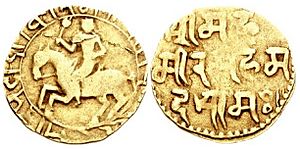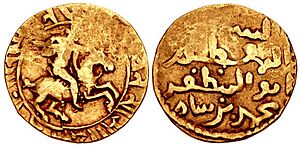Muhammad Bakhtiyar Khalji facts for kids
Quick facts for kids Ikhtiyar al-Din Muhammad Bakhtiyar Khalji |
|||||
|---|---|---|---|---|---|
| Ruler of (Bengal) | |||||
| Reign | c. 1203 – 1206 | ||||
| Predecessor | (Position established) | ||||
| Successor | Muhammad Shiran Khalji | ||||
| Born | c. 1150 Garmsir, Helmand, Afghanistan |
||||
| Died | c. 1206 Devkot , South Dinajpur, West Bengal |
||||
| Burial | 1206 Pirpal Dargah, Narayanpur, Gangarampur, West Bengal |
||||
|
|||||
| Clan | Khilji | ||||
| Religion | Sunni Islam | ||||
| Occupation | Military general ruler |
||||
Ikhtiyār al-Dīn Muḥammad Bakhtiyār Khaljī, often called Bakhtiyar Khalji, was a military leader from a region that is now Afghanistan. He served the Ghurid ruler Muhammad of Ghor. Bakhtiyar Khalji led important conquests in eastern India, including parts of Bengal and Bihar. He then became their ruler.
He founded the Khalji dynasty of Bengal, which ruled Bengal for a short time, from 1203 to 1227 CE. His invasions between 1197 and 1206 CE caused big changes in Northern India. They led to the decline of traditional Buddhist learning centers. In Bengal, his rule also led to the decline of Buddhism.
The famous Buddhist university of Nalanda was a leading center for Mahayana Buddhism. Some accounts say Bakhtiyar Khalji attacked and damaged it. However, some historians believe that these Buddhist sites were already empty or in decline before his attacks.
His rule is seen as the start of Muslim rule in Bengal. Later, this led to the Bengal Sultanate and Mughal Bengal. Bakhtiyar Khalji tried to invade Tibet in 1206, but it did not go well. He was killed when he returned to Bengal. Muhammad Shiran Khalji took over after him.
Contents
Early Life and Beginnings
Bakhtiyar Khalji was born and grew up in Garmsir, which is in present-day southern Afghanistan. He was part of the Khalaj tribe, who were originally from Turkic groups. Over time, this tribe settled in Afghanistan and became known as the Ghilji tribe.
When he was young, Bakhtiyar looked for work in cities like Ghazni and Delhi. He was even turned down in Delhi because of his looks. Later, he moved to Badaun in present-day Uttar Pradesh, India. There, he finally found his first job.
Bakhtiyar was not from a completely unknown family. His uncle, Muhammad bin Mahmud, had fought in a big battle called the Second Battle of Tarain. Bakhtiyar later inherited some land from his uncle. He also impressed a commander named Husamudin Aghul Bek with his bravery. This commander gave him more land to control.
Before his major campaigns in Bengal and Bihar, Bakhtiyar became famous through successful raids. He took valuable goods from areas in present-day Uttar Pradesh, Maner, and Bihar. These successful raids made him well-known. Many other Khalji warriors joined his service. Even Qutb ud-Din Aibak, a powerful ruler, honored him.
Military Achievements
Bakhtiyar Khalji was a key military leader for the Ghurid Empire. He led the forces that conquered parts of eastern India around the late 1100s and early 1200s.
Conquering Bihar and Impact on Buddhist Centers (1200)
Bakhtiyar Khalji took control of much of Bihar in the year 1200. His invasions affected important Buddhist learning centers, known as Mahaviras. These included places like Odantapuri and Vikramashila.
Historical writings, like the Tabaqat-i Nasiri, describe Bakhtiyar Khalji's attack on a Buddhist monastery. The author of this text called the place "Bihar" because soldiers used the word vihara (monastery). Another scholar from the 1600s, Taranatha, wrote that many monks were killed at Odantapuri and Vikramashila was destroyed.
Some historians, like Satish Chandra, believe Bakhtiyar was directly involved in destroying these Mahaviharas. However, other historians, such as D.N. Jha and Namit Arora, suggest that these sites might not have been destroyed by him. They argue that the sites could have already been abandoned or in decline.
Conquering Bengal (1203)
In 1203, Khalji invaded Bengal. The ruler of Bengal at that time was Lakshmana Sena, who was very old. His Sena dynasty was already weakening and could not put up much of a fight.
It is said that Khalji moved so quickly towards the city of Nabadwip that only 18 horsemen could keep up with him. This small group entered the city by surprise. They caught the emperor and his army off guard. Lakshmana Sena had to flee with his helpers to eastern Bengal.
After this, Khalji captured Gauda, which was the capital of Bengal. He then took control of a large part of Bengal.
A historian named Minhaj al-Siraj wrote about Muhammad Bakhtiyar's rule. He visited Bengal about 40 years later. He wrote:
After Muhammad Bakhtiyar took control of that area, he left the city of Nudiah empty. He made the place now called Lakhnauti his main city. He brought different parts of the land under his control. He started the reading of the khutbah (a sermon) and the making of coins. Thanks to his efforts and those of his leaders, masjids (mosques), colleges, and monasteries were built in those areas.
Failed Invasion of Tibet (1206)
In 1206, Bakhtiyar Khalji left the town of Devkot to attack Tibet. He left Ali Mardan Khalji in charge of guarding the eastern border.
Bakhtiyar Khalji's army faced a terrible defeat in Tibet. Tibetan guerrilla fighters attacked his forces in the Chumbi Valley. This forced him to retreat to Devkot with only about a hundred soldiers left. This was a very difficult and shameful defeat for Khalji.
Death and What Happened Next
After his defeat in Tibet, Bakhtiyar Khalji was sick and tired in Devkot. He was then killed by Ali Mardan Khalji.
The Khalji noblemen chose Muhammad Shiran Khalji to take Bakhtiyar's place. Shiran Khalji's loyal troops and Subedar Aulia Khan got revenge for Ikhtiyar's death. They put Ali Mardan Khalji in prison.
However, Ali Mardan escaped and went to Delhi. He convinced the Sultan of Delhi, Qutb al-Din Aibak, to invade Bengal. The Sultan sent an army, and Shiran Khalji had to flee. He later died.
Ghiyas-ud-din Iwaz Khalji helped with the invasion and became the governor of Bengal in 1208. But he later gave up power to Ali Mardan when Ali Mardan returned from Delhi in 1210. However, the nobles of Bengal plotted against Ali Mardan and killed him in 1212. Iwaj Khalji then took power again and declared that he was independent from the Delhi Sultanate.
Legacy
Muhammad Bakhtiyar Khalji had sermons read and coins made in his name. Mosques, madrasas (schools), and khanqahs (places for spiritual gatherings) were built because of his support. His actions were copied by those who worked for him.
See also
- List of rulers of Bengal#Delhi Sultanate era
- Bakhtiarpur
Images for kids




